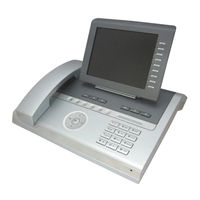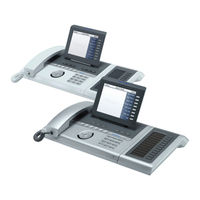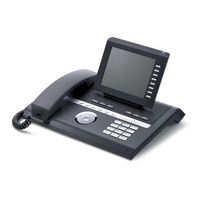Siemens OpenStage 60 T Manuals
Manuals and User Guides for Siemens OpenStage 60 T. We have 4 Siemens OpenStage 60 T manuals available for free PDF download: User Manual, Operating Instructions Manual, Quick Reference Manual
Siemens OpenStage 60 T User Manual (199 pages)
for HiPath 500, HiPath 3000, HiPath 5000
Table of Contents
-
-
-
Features16
-
-
-
Mode Keys19
-
Touchguide20
-
Keypad24
-
-
Appearance25
-
-
-
-
Phonebooks34
-
Call Lists37
-
Mailbox39
-
Menu40
-
-
Making Calls47
-
-
Making Calls59
-
-
-
Privacy/Security
109-
User Password109
-
Do Not Disturb111
-
Saving Your PIN116
-
-
-
-
Lines133
-
Line Utilization133
-
Line Seizure134
-
-
Trunk Keys134
-
-
-
En-Bloc Dialing164
-
Context Menu172
-
Phone Test175
-
Bluetooth
176-
Discoverability176
-
Linking176
-
-
Sending a Vcard178
-
-
Fixing Problems
186 -
Index
189 -
Display Icons
198
Advertisement
Siemens OpenStage 60 T Operating Instructions Manual (178 pages)
Table of Contents
-
-
-
Mode Keys17
-
Touchguide18
-
Keypad21
-
-
Appearance22
-
-
-
-
Phonebooks31
-
Call Lists34
-
Mailbox36
-
Menu37
-
-
Making Calls43
-
-
Making Calls59
-
-
-
Do Not Disturb100
-
Saving Your PIN105
-
-
-
Lines122
-
Line Utilization122
-
Line Seizure123
-
-
Trunk Keys123
-
-
-
Context Menu158
-
Bluetooth
161-
Discoverability161
-
Linking161
-
-
Sending a Vcard163
-
-
Fixing Problems
166 -
Index
169
Siemens OpenStage 60 T Operating Instructions Manual (162 pages)
Brand: Siemens
|
Category: Telephone System
|
Size: 4 MB
Table of Contents
-
-
-
Mode Keys17
-
Touchguide18
-
Keypad20
-
-
Appearance22
-
-
-
-
Phonebooks30
-
Call Logs33
-
Mailbox35
-
Menu37
-
-
Making Calls43
-
-
Making Calls58
-
-
-
LDAP Database100
-
Call Logs101
-
View Details101
-
Deleting Entries101
-
-
Privacy/Security
104 -
-
Line Keys111
-
Line Utilization112
-
Preview113
-
Line Mailbox118
-
Ring Transfer126
-
-
-
-
-
Screensaver134
-
Color Scheme136
-
-
Context Menu149
-
Bluetooth
152-
Discoverability152
-
Linking152
-
-
Sending a Vcard154
-
-
Fixing Problems
156 -
Index
159
Advertisement
Siemens OpenStage 60 T Quick Reference Manual (10 pages)
Table of Contents
Advertisement



